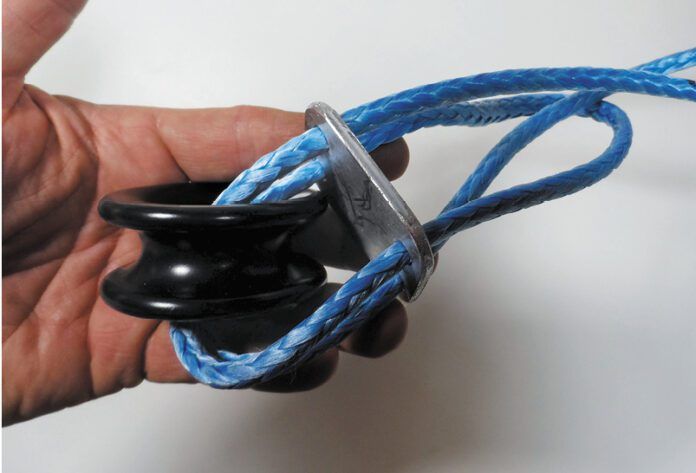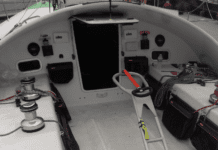We’re not racers. A few ounces doesn’t matter to us, so why should we be interested in Dyneema, or any of the other popular brands of line made with low-stretch, high-strength, high-molecular-weight-polyethylene fibers (HMWPE).
Economy. Dyneema seems expensive, but extremely versatile single-braid Dyneema compares with double-braid polyester on a dollar/strength basis. In terms of durability, single-braid HMWPE lines are lasting longer than we initially expected; manufacturers tout a service life of about nine years, and we’ve confirmed that in the field.
Easy splicing. Splicing double-braid polyester takes practice, tools, and time; if the rope is used, it’s impossible to splice. Single braid, on the other hand is simpler to splice than tying some knots. The only tool you need is a length of rigging wire. You can even resplice old line. We frequently adjust our long-bury splices (www.animatedknots.com/long-bury-splice-knot). Resplicing is even easier with a Brummel splice (www.animatedknots.com/brummel-eye-splice-knot)?
Soft shackles. Stainless shackles can scrape on the mast, boom, or deck. They can rattle annoyingly on the boom. Metal fittings on a headsail clew can be dangerous when the sail flogs. A bowline or luggage tag knot works at the clew, but sometimes you want sheets that can be easier to remove. Soft shackles can be stronger than any metal shackle that will fit through a tight place—for example through the anchor chain when attaching a snubber. However, for most running rigging applications, we prefer stainless shackles for their superior wear resistance.
Wire halyard substitute. Wire halyards have long been out of favor. They are hard to use, prone to failure, and the rope-to-wire splices are prickly to handle and difficult to make. Dyneema has proven an excellent substitute for wire rope. If you convert from wire rope to Dyneema halyard, meticulously polish the sheaves to remove any burrs.
Lifeline substitute. Dyneema can chafe in stanchions, so it is still not approved under all racing rules (see “Revised Lifeline Protection Plan,” PS September 2021). Still, we have found it very useful for filling gaps, creating gates, and other applications where we needed more flexible rope.
Rigging. The fatigue life of HMWPE is very good, but it requires design and installation adaptations for standing rigging applications. As for running rigging, Dyneema’s strength, low-stretch, slipperiness, and chafe resistance it makes it perfect for many adjustment lines. Reefing lines, in-boom outhauls, Barberhaulers, and vangs can take advantage of single braid, but you will want to cover the tails to make them easier to handle. Avoid uses where you want shock absorption, such as topping lifts and travelers. Dyneema sheets don’t offer much advantage, except on boats over 40 feet.
Strong Loops. We’ve used Dyneema loops and soft shackles as a way of crowding more lines on a cleat for storms. Just drop a loop at the base of the cleat, and luggage-tag nylon dock lines to that. To prevent the Dyneema from chafing through the line, you can thread a tubular webbing chafe sleave over the nylon.
Bottom line: Cruising sailors can undoubtedly benefit from low-stretch, high-strength HMWPE lines, but they need to consider the material’s strengths and weaknesses before putting them to work.








































